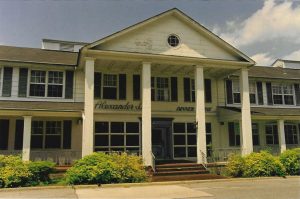-300x225.jpg)
For over a decade, the Atomic Heritage Foundation has worked to preserve the Y-12 Plant and protect critical World War II heritage tourism sites in Oak Ridge, including the Alexander Inn.
Every year Oak Ridge is home to the vibrant Secret City Festival. The Department of Energy runs a bus tour of its Oak Ridge facilities in the summer through the excellent American Museum of Science and Energy. To see a map of relevant historic districts and sites in Oak Ridge, please click here.
K-25 Plant
The once mile-long K-25 gaseous diffusion plant played a critical role in both the Manhattan Project and Cold War by enriching uranium. In recognition of its significance, in 2005 the Department of Energy committed to maintaining a portion of the North End of the K-25 plant. The agreement was signed in a Memorandum of Agreement with the Department of Energy’s Federal Preservation Officer, Tennessee State Historic Preservation Officer and the Advisory Council on Historic Preservation. In 2009, the Department of Energy proposed modifying the MOA to allow for the demolition of the entire plan as the preservation had “proven impractical.”

The K-25 Plant at Oak Ridge
On November 17, 2011, the Department of Energy (DOE) convened representatives of the Advisory Council on Historic Preservation (ACHP), Tennessee Historical Commission, and other parties to present their mitigation plans for the K-25 plant. At that meeting, Oak Ridge Operations manager John Eschenberg announced DOE’s intention to demolish all of the K-25 plant. Eschenberg said that saving a piece of the K-25 plant would be “imprudent” as the work would be “unsafe” and “too costly.” Over half of the K-25 plant and more than 100 other Manhattan Project buildings at the K-25 site have already been demolished.
In January 2012, under Section 213 of the National Historic Preservation Act, the Advisory Council on Historic Preservation requested that the National Park Service (NPS) assess how the plant’s complete demolition could affect the interpretation of the property. The National Park Service report made its case clear. “Because the K-25 building has no substitute, the NPS considers it vital that the maximum practical amount of the original building and equipment be preserved to enable the best possible interpretation of this facility and its operation.” NPS argued that the nation has a vital interest in preserving a portion of the K-25 plant.

The Alexander Inn at Oak Ridge
AHF worked in partnership with the National Trust for Historic Preservation and local historic preservation groups to preserve a sliver of the historic building. However, DOE officials announced in November 2011 that saving a portion of the building was “imprudent.” Unfortunately, DOE rejected the proposal to preserve a small sliver of the plant. On December 17, 2013, DOE completed its demolition of the K-25 gaseous diffusion plant. DOE has agreed to recreate a portion of the plant with exhibits nearby, but at this time there are no funds for this work.
The Alexander Inn
During the Manhattan Project, many top Manhattan Project scientists and personnel, including General Leslie Groves, J. Robert Oppenheimer, and Enrico Fermi, stayed at the Alexander Inn guest house. The inn has been rescued after being abandoned nearly a decade ago and is currently being restored and renovated. The Family Pride Corporation of Loudon, TN is undertaking a $5.5 million project to convert the property into a senior assisted living center.

Knox Heritage and East Tennessee Preservation Alliance nominated Oak Ridge’s Alexander Inn for the 2014 The National Trust/Advisory Council on Historic Preservation Award for Federal Partnerships in Historic Preservation. The East Tennessee Preservation Alliance has also removed the historic Alexander Inn from its annual list of East Tennessee’s Endangered Heritage sites.
X-10 Graphite Reactor
The X-10 Graphite Reactor or “Clinton Pile” was a pilot plant for the full-scale plutonium production reactors that were being built at Hanford. In 1946, X-10 began producing peacetime radioisotopes for use in industry, agriculture, medicine and research. The pile was permanently shut down in 1963 and designated a National Historic Landmark in 1966 and a National Historic Chemical Landmark in 2008. The reactor has also been recently renovated and is often included in tours provided by ORNL to visitors.
Y-12 Plant
The massive Y-12 plant at Oak Ridge was designed to enrich uranium using calutrons, which adapted the electromagnetic separation method developed by Ernest O. Lawrence. Despite being plagued by troubles, the Y-12 plant eventually produced the enriched uranium for the first atomic bomb. But the calutrons required an exorbitant amount of energy and over 22,000 employees. In December 1946, all of the Y-12 calutrons were shut down, except for the 36 calutrons in the Beta 3 building and the pilot units in Building 9731.
Starting in 1959, the Beta 3 calutrons were used to produce over 200 stable isotopes used for cancer treatment, medical diagnostics, nonproliferation, and other applications. In 1998, production was shut down but the control room and other portions of the facility remain as they were in 1945.
Chapel-On-The-Hill

The Chapel on the Hill
The U.S. Army Corps of Engineers built the Chapel-on-the-Hill to accommodate the growing demands of Oak Ridgers for a place of worship. As the pastor of Knoxville’s First Baptist Church dedicated it on September 30, 1943, he referred to it as the “Chapel-on-the-Hill” in a prayer and the name stuck. The chapel was a common place for wedding ceremonies for Oak Ridgers during the Manhattan Project.
Despite its popularity, after the war the chapel faced a crisis when Tennessee Eastman employees, who comprised 40 percent of the worshipers, were terminated. However, the church was preserved because of Reverend B.M. Larson’s leadership. Today, the Chapel retains its ecumenical feel and has activities throughout the year. Its historic significance was recognized in 1993 when it was added to the National Register of Historic Places.




